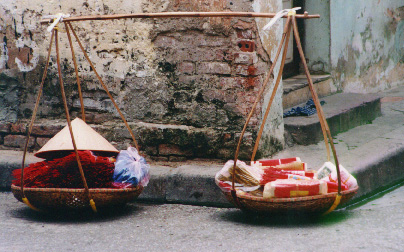

|
|
This day we were "on our own," and it began rather badly for me. I determined to walk down to the South end of the lake to find the two international bookstores on Trang Tien street. But it began to rain heavily, so I snagged a cycle, overpaid (and knew it) for the 6-block ride, took a wrong turn on foot and ended up in a warren of backstreets where everyone was puzzled to see a confused hatless foreigner wandering around in the rain. Fortunately, the language barrier was a readily available excuse for not asking directions. My cycling jacket was completely inadequate against the monsoon, but I meandered on, steadfastly refusing the offers of brightly colored rain ponchos at every turn, and even some conical hats. I finally did return to the lake, where I purchased a quite servicable blue cap with a bill, bargaining down from $2 to $1. (A very well-made cap, I have to say some months later -- it continues to provide good service in the Mid-Atlantic winter.) After a few more minutes wandering the lake, I finally realized that had made a near-complete circuit, and was close to the hotel but hopelessly far from the bookstore. So I returned for lunch with the others. Back in the room, I found they had taken my pile of clothes and sent them to the laundry, assuming that was the sensible thing to do (other than burning them). So it was a quick foray to the clothing shop next-door, an upscale place that operated according to Western rules: fixed price, salaried clerks, who didn't seem to particularly care if you bought anything or not. I revelled in the privacy and peace of mind as I selected a slick-looking shirt for 144,000 dong. It was well worth the price for air conditioning and a moment's respite from the bustle of commerce. |
|
|
|
|
Three to a bike in the
wet streets of Hanoi, and two schoolgirls. |
|
|
|
|
|
|
That afternoon Robert, Rachel, Deborah and I took a cab out to the Ethnographic Museum. It was a half-hour drive out to an obscure suburb-probably less if the cab driver doesn't circle around the destination asking directions. The Museum was the best thing I saw in Hanoi (well, perhaps tied with the Water Puppet Theatre). Built with the assistance of the French, it was well-laid out in a circular building with two floors of exhibits and artifacts documenting many of the 50-some ethnic minorities of the country. Someone had taken the trouble to assemble replicas of village huts, set up videotapes of some of the weaving and dyeing processes, and translate the display notes into good English. It was a shame that we saw only 2 or 3 other visitors during our tour.
|
|
|
Our last evening began with a wild bus ride to a far corner of town, to find an opulent Chinese restaurant tucked away down a narrow alley. The Chinese of Vietnam have persevered, and in many cases even prospered, despite persecution from the government and the forcible deportation of 500,000 who wound up in refugee camps in South China. Given this sad and recent history, it was amazing to find ourselves in the most modern and well-kempt restaurant of our tour: Brightly lit, with perfectly varnished wood floors and railings, immaculate furniture, and a wireless microphone being passed around the tables for a ghastly round of karaoke. The owners were getting along quite well indeed, perhaps proving that the right protection money to the right officials could overcome just about anything. Followed a final salvo of the exotic, the raw, the cooked, the peculiar, and in some cases the grotesque (to Western taste) cuisine of this corner of the Orient. Don't get me wrong--I enjoyed what I ate. But I only ate from about a fourth of the courses. There was no need for self-criticism, I thought. My culinary experience was probably authentic, as the majority of the Vietnamese make do with a short menu and very little meat. And after that, it was a quick ride back over to East Lake for the Water Puppet Theatre, the other most wonderful thing (along with the Ethnographic Museum) that I found in Hanoi. A small orchestra in traditional dress sat at stage right, and began the performance with singing and instrumental accompaniment.
|
|
|
The water puppets were manipulated by a troupe of about eight who stood in waist-high water, hidden behind a screen. Using long poles, they moved the wooden puppets around on the pool that was center stage, creating processions, boat races, a fox chasing a duck, dragons cavorting in the smoke drifting across the water from a fusillade of firecrackers. In all, it took about an hour and a quarter, and was a most delightful coda to our stay in Hanoi. We bid adieu in a light rain, those of us planning to leave early the next day heading straight to bed. It had been a good crew, probably the best I have ever had the pleasure of travelling with. For some of us, it wasn't quite over. Stephanie and Jackie were headed off to adventures around Da Nang and west to Cambodia. Charles was taking his two Leicas and his GPS on another tour headed south. And I had other destinations in mind as well, rising at four in the morning to take my bags down to the silent courtyard and wait for the taxi to take me to the airport.
|